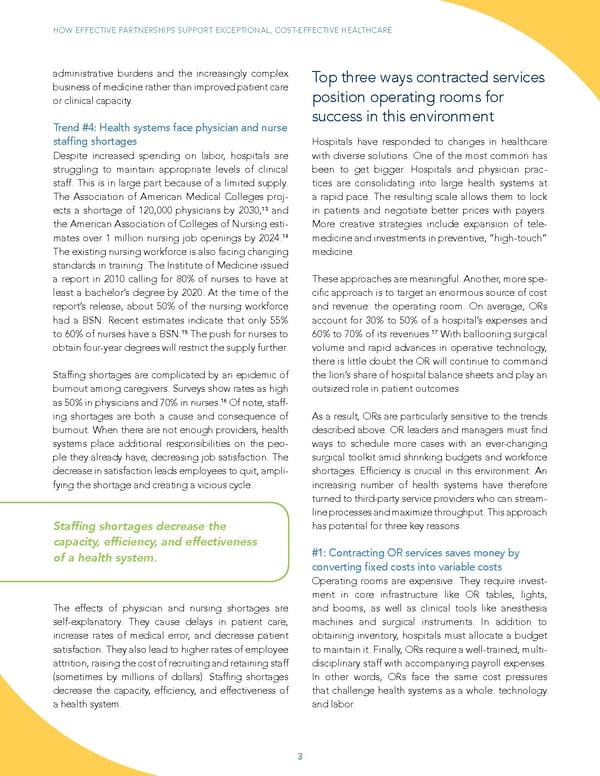HOW EFFECTIVE PARTNERSHIPS SUPPORT EXCEPTIONAL, COST-EFFECTIVE HEALTHCARE administrative burdens and the increasingly complex Top three ways contracted services business of medicine rather than improved patient care position operating rooms for or clinical capacity. Trend #4: Health systems face physician and nurse success in this environment staffing shortages Hospitals have responded to changes in healthcare Despite increased spending on labor, hospitals are with diverse solutions. One of the most common has struggling to maintain appropriate levels of clinical been to get bigger. Hospitals and physician prac- staff. This is in large part because of a limited supply. tices are consolidating into large health systems at The Association of American Medical Colleges proj- a rapid pace. The resulting scale allows them to lock 13 ects a shortage of 120,000 physicians by 2030, and in patients and negotiate better prices with payers. the American Association of Colleges of Nursing esti- More creative strategies include expansion of tele- 14 mates over 1 million nursing job openings by 2024. medicine and investments in preventive, “high-touch” The existing nursing workforce is also facing changing medicine. standards in training. The Institute of Medicine issued a report in 2010 calling for 80% of nurses to have at These approaches are meaningful. Another, more spe- least a bachelor’s degree by 2020. At the time of the cific approach is to target an enormous source of cost report’s release, about 50% of the nursing workforce and revenue: the operating room. On average, ORs had a BSN. Recent estimates indicate that only 55% account for 30% to 50% of a hospital’s expenses and 15 17 to 60% of nurses have a BSN. The push for nurses to 60% to 70% of its revenues. With ballooning surgical obtain four-year degrees will restrict the supply further. volume and rapid advances in operative technology, there is little doubt the OR will continue to command Staffing shortages are complicated by an epidemic of the lion’s share of hospital balance sheets and play an burnout among caregivers. Surveys show rates as high outsized role in patient outcomes. as 50% in physicians and 70% in nurses.16 Of note, staff- ing shortages are both a cause and consequence of As a result, ORs are particularly sensitive to the trends burnout. When there are not enough providers, health described above. OR leaders and managers must find systems place additional responsibilities on the peo- ways to schedule more cases with an ever-changing ple they already have, decreasing job satisfaction. The surgical toolkit amid shrinking budgets and workforce decrease in satisfaction leads employees to quit, ampli- shortages. Efficiency is crucial in this environment. An fying the shortage and creating a vicious cycle. increasing number of health systems have therefore turned to third-party service providers who can stream- line processes and maximize throughput. This approach Staffing shortages decrease the has potential for three key reasons. capacity, efficiency, and effectiveness #1: Contracting OR services saves money by of a health system. converting fixed costs into variable costs Operating rooms are expensive. They require invest- ment in core infrastructure like OR tables, lights, The effects of physician and nursing shortages are and booms, as well as clinical tools like anesthesia self-explanatory. They cause delays in patient care, machines and surgical instruments. In addition to increase rates of medical error, and decrease patient obtaining inventory, hospitals must allocate a budget satisfaction. They also lead to higher rates of employee to maintain it. Finally, ORs require a well-trained, multi- attrition, raising the cost of recruiting and retaining staff disciplinary staff with accompanying payroll expenses. (sometimes by millions of dollars). Staffing shortages In other words, ORs face the same cost pressures decrease the capacity, efficiency, and effectiveness of that challenge health systems as a whole: technology a health system. and labor. 3
 Surgical Solutions White Paper Page 4 Page 6
Surgical Solutions White Paper Page 4 Page 6